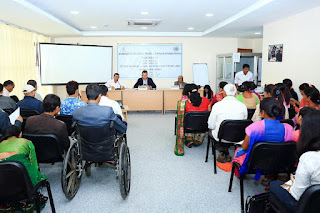International development partners, the United Nations Development Programme, the judiciary and the academia in Nepal have called for stronger efforts from all quarters to prevent and fight corruption, which poses a serious threat to the realization of the Sustainable Development Goals (SDGs).
Speaking at an interaction programme organized by Law Campus with the support of UNDP, the representatives from donors’ community, UNDP and the Supreme Court said combating corruption is critical to meeting the 2030 Agenda for Sustainable Development.
British Ambassador to Nepal, Richard Morris, said corruption and poor governance were constraining Nepal’s economic potential, posing a barrier to investment, growth and poverty reduction. “Foreign investors are deterred by practices that do not provide a level playing-field,” he said, “Successful anti-corruption efforts are an effective way to build investor confidence.” He rounded off his talk by applauding the dynamism, commitment and ambition of the young people in Nepal. “You can make this the country you want it to be,” he told the students at the programme.
Ambassador of the EU delegation to Nepal, Rensje Teerink, in her remarks, talked of the “social and moral” exigency of tackling the issue of corruption. She referred, notably, to Transparency International’s Corruption Perception Index of 2015, which had ranked Nepal 130th out of 168 surveyed countries on the basis of corruption, as an illustration of the seriousness of the issue and the work to be done.
Chief Justice of the Supreme Court, Sushila Karki, also the Chief Guest at the event, highlighted some of the commitments and the achievements the country had made in the fight against corruption, with particular focus on the judiciary’s performance. She said that there were still hurdles aplenty in their path, and among these was the difficulty of putting together a strong, diverse workforce. “In Nepal, we have people who can’t find jobs, and jobs for which we can’t find people,” she said. The Chief Justice urged the students to put themselves forward and join the fight against corruption.
Sophie Kemkhadze, UNDP’s Deputy Country Director in Nepal, elaborated on how the SDGs represented a “transformative agenda” not just for Nepal, but the world at large. The costs of corruption, she said, are not merely in the abstract, there is a concrete price tag, where every year, a hefty $1.26 trillion is lost in developing countries, and $2.6 trillion globally to corruption. “Fighting corruption is not only an issue for the government but one in which each and every one of us have a role to play,” she said imploring the students to be part of an informed and responsible citizenry as well as reaffirming the UNDP’s commitment to anti-corruption efforts.
The interaction was organized with the support of UNDP through its Strengthening Rule of Law and Human Rights Protection System in Nepal Programme (RoLHR), the Government of Nepal, and the Embassies of Denmark, Norway and Finland.
A short interaction session followed the talks, where students raised questions on matters of corruption, sustainability and the law, which were answered by the speakers.
This year’s International Anti-Corruption Day is themed “Corruption: An Impediment to the SDGs”. [UNDP Nepal Press Note issued on Dec 9, 2016]











